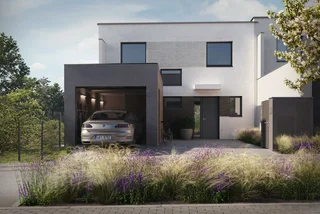Written by Sarah Castille
for Expats.cz
Judging from its recent choice of exhibits — this winter´s Uncertain States of America and the current Gregory Crewdson exhibit – it appears that The Rudolfinum is creating a niche for itself in artistic explorations of American discontent. While one might be tempted to wonder why the Rudolfinum´s curators have spent so much time gazing across the ocean when there are so many first rate European and Czech artists here at home, the Crewdson exhibit is a fine thing for Prague – a first rate exhibit by a first rate artist that certainly deserves the attention of anyone interested in contemporary photography or filmmaking.
Although his primary subject is undoubtedly the hidden pathos of small town Americana, Crewdson´s work is just as relevant to a European audience as to an American one. He does not explore the realities of American life as much as our perceptions of them – perceptions that extend beyond the borders of the United States and into the global sphere. More often than not, our notions of life in the United States have crossed the ocean riding on the back of the mainstream American film industry, which has unfortunately acquired the responsibility of creating, defining, and filtering the images through which we in Europe have come to understand both the short-comings and successes of American society. By placing the film industry under the intense scrutiny of the camera lens, Crewdson has much to teach us – not as much about how people are living in the United States, but how we, as a global community, perceive that lifestyle and how mass-marketed popular culture defines and shapes those perceptions.
Take Hover, for instance. The earliest of Crewdsons´ series on display, the collection features plain, flat images of American suburban life that appear banal until further scrutiny reveals unsettling idiosyncrasies – a woman´s lifeless legs protruding from a doghouse, a dog collector standing poised in a Wild West standoff with his pistol pointed at a bear rummaging through the trash, firefighters helplessly holding limp hoses in the aftermath of a fire that broke out during a child´s birthday party, party balloons still dangling from the columns of the front porch and unopened gifts sodden in the front lawn. Yet, as disturbing as these images may be, they are also familiar. We have seen them all before, not hung on the wall in a museum or art gallery, but flashing across our late-night television screens on an episode of Cops or Unsolved Mysteries. They both confirm and question our preconceptions about life in the United States, pitting the suburban American dream against the violent fantasies of the television industry.
Crewdson´s beautiful, grotesque images reveal the hidden perversities of American small town life in a manner often closer to David Lynch than Cindy Sherman, the contemporary photographer to whom he is most often compared. While he shares a flair for the cinematic and a love of the ghastly and gruesome with Sherman, the way in which he manages to spin even the blandest visions of Americana into a sort of eerie unreality is pure Mulholland Drive. Crewdson shoots his photographs like films as well, employing massive production crews, expensive special effects teams, and big name stars like Gwyneth Paltrow and Julianne Moore. He blocks off entire city streets when he shoots “on location” and builds meticulously arranged interiors and precise outdoor settings when conditions force him to work on a soundstage. In interviews, Crewdson even uses film terminology to describe his work – post-production, pre-production, the “cast” and “crew.” This is a vocabulary that belongs more to the cinematographer than the photographer, and it betrays the extent to which even at the most basic level, Crewdson refuses to draw a line between film and photography, interlacing contemporary photography´s penchant for social excavations with the fairytale digital-reality and star quality of Hollywood (or Sundance, as the case may be).
This is most true of some of Crewdson´s finest work on display: his series Twilight, Beneath the Roses, and particularly Dream House, a collection of photos shot for New York Ties Magazine that Crewdson calls “single frame movies.” In these collections we find the strongest expression of the central theme resonating throughout the exhibit: the juxtaposition of the quiet, hidden perversities of our private lives with their wildly exaggerated reflections splayed across film screens and prime-time television. The scenes we find acted out in Crewdson´s work – and they are literally acted out, no gritty documentaries here – are less scenes taken from real life as scenes taken from movie portrayals of real life: the middle class family sitting in uncomfortable silence at the dinner table; mystical beams of light shining from sewage grates or descending upon small town residents in the prologue to a UFO abduction, people unearthing (or burying?) hidden treasures beneath floorboards and in darkened forests. Like any film, Crewdson´s photographs tell stories, but the stories he has chosen are more reminiscent of Edgar Allan Poe than Raymond Carver.
Crewdson opens the doors to a post-modern fantasy world where we are forced to peer through the looking glass into the mass-produced mirages lurking beneath our notions of reality. He does not invite us to question the perversities of the American suburban lifestyle as much as why representations of these perversities are so attractive, why we buy them so readily when we see them at the cinema or on prime-time television, and what they ultimately tell us about ourselves – our beliefs, our anxieties, our fears, and, ultimately, our gullibility.
Although the prospect of wading through the crowds of tourists flooding the city center never sounds enticing, during the next two weeks you must make time to see this exhibit.
It is located at the Rudofinium Gallery, Alšovo nábřeží 12, open 10 AM to 6PM, closed Mondays. It will run until May 25, 2008.












 Reading time: 4 minutes
Reading time: 4 minutes 





















